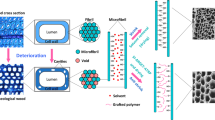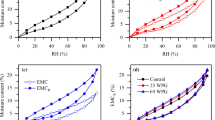Abstract
During the dehydration of waterlogged archaeological wood (WAW), shrinkage inevitably occurs due to capillary force and hydrogen bond recombination as WAW loses free and adsorbed water. Existing drying techniques, including solvent displacement, freeze-drying, and supercritical fluid drying, only take effect by reducing or eliminating the surface tension of liquid. Nonetheless, the contribution of hydrogen bond recombination in shrinkage has long been neglected and a countermeasure concerning this problem is needed. In this study, we propose a simple aqueous phenylboronic acid (PBA) treatment that can help improve dimensional stability and reduce hygroscopicity of WAW. Analysis by Fourier transform infrared spectroscopy, density functional theory calculation and dynamic vapour sorption reveal that PBA can incorporate with hydroxyl groups (–OH) on cellulose through coordination and hydrogen bonds, occupy the water-cellulose binding sites, and possibly inhibit the formation of hydrogen bonds between adjacent cellulose chains.








Similar content being viewed by others
Availability of the data and material
All the data are available upon reasonable requests.
References
Ambrose WR (1989) Application of freeze-drying to archaeological wood. Archaeol Wood. https://doi.org/10.1021/ba-1990-0225.ch010
Argaman N, Makov G (2000) Density functional theory—an introduction. Am J Phys 68(1):69–79. https://doi.org/10.1119/1.19375
Babiński L (2015) Dimensional changes of waterlogged archaeological hardwoods pre-treated with aqueous mixtures of lactitol/trehalose and mannitol/trehalose before freeze-drying. J Cult Herit 16(6):876–882. https://doi.org/10.1016/j.culher.2015.03.010
Basu S, Shivhare US, Mujumdar AS (2006) Models for sorption isotherms for foods: a review. Dry Technol 24:917–930. https://doi.org/10.1080/07373930600775979
Björdal CG (2012) Microbial degradation of waterlogged archaeological wood. J Cult Herit 13:S118–S122. https://doi.org/10.1016/j.culher.2012.02.003
Björdal CG, Nilsson T, Daniel G (1999) Microbial decay of waterlogged archaeological wood found in Sweden applicable to archaeology and conservation. Int Biodeter Biodegr 43:63–73. https://doi.org/10.1016/S0964-8305(98)00070-5
Blanchette RA (2000) A review of microbial deterioration found in archaeological wood from different environments. Int Biodeter Biodegr 46:189–204. https://doi.org/10.1016/S0964-8305(00)00077-9
Broda M, Hill C (2021) Conservation of waterlogged wood—past, present and future perspectives. Forests 12:1193. https://doi.org/10.3390/f12091193
Broda M, Mazela B (2017) Application of methyltrimethoxysilane to increase dimensional stability of waterlogged wood. J Cult Herit 25:149–156. https://doi.org/10.1016/j.culher.2017.01.007
Broda M, Plaza NZ (2023) Durability of model degraded wood treated with organosilicon compounds against fungal decay. Int Biodeterior Biodegrad 178:105562. https://doi.org/10.1016/j.ibiod.2022.105562
Broda M, Yelle DJ (2022) Reactivity of waterlogged archeological elm wood with organosilicon compounds applied as wood consolidants: 2D 1H–13C solution-state NMR studies. Molecules 27:3407. https://doi.org/10.3390/molecules27113407
Cavallaro G, Lazzara G, Milioto S, Parisi F, Ruisi F (2017) Nanocomposites based on esterified colophony and halloysite clay nanotubes as consolidants for waterlogged archaeological woods. Cellulose 24:3367–3376. https://doi.org/10.1007/s10570-017-1369-8
Chen CM, Wangaard FF (1968) Wettability and the hysteresis effect in the sorption of water vapor by wood. Wood Sci Technol 2:177–187. https://doi.org/10.1007/BF00350907
Chen W, Leung V, Kroener H, Pelton R (2009) Polyvinylamine-phenylboronic acid adhesion to cellulose hydrogel. Langmuir 25(12):6863. https://doi.org/10.1021/la900131g
Dunning TH (1989) Gaussian basis sets for use in correlated molecular calculations. I. The atoms boron through neon and hydrogen. J Chem Phys 90(2):1007–1023. https://doi.org/10.1063/1.456153
Endo R, Sugiyama J (2022) New attempts with the keratin-metal/magnesium process for the conservation of archaeological waterlogged wood. J Cult Herit 54:53–58. https://doi.org/10.1016/j.culher.2022.01.002
Faniran JA, Shurvell HF (1968) Infrared spectra of phenylboronic acid (normal and deuterated) and diphenyl phenylboronate. Can J Chem 46(12):2089–2095. https://doi.org/10.1139/v68-341
Garside P, Wyeth P (2003) Identification of cellulosic fibres by FTIR spectroscopy—thread and single fibre analysis by attenuated total reflectance. Stud Conserv 48(4):269–275. https://doi.org/10.1179/sic.2003.48.4.269
Grimme S, Hansen A, Ehlert S, Mewes J (2021) r2SCAN-3c: A “Swiss army knife” composite electronic-structure method. J Chem Phys 154(6):064103. https://doi.org/10.1063/5.0040021
Guo J, Chen J, Meng Q, Ploszczanski L (2022) Molecular and crystal structures of cellulose in severely deteriorated archaeological wood. Cellulose 29:9549–9568. https://doi.org/10.1007/s10570-022-04856-4
Guo J, Xiao L, Han L, Wu H, Yang T, Wu S, Yin Y (2019) Deterioration of the cell wall in waterlogged wooden archeological artifacts, 2400 years old. Int Assoc Wood Anat 40:820–844. https://doi.org/10.1163/22941932-40190241
Guo J, Zhou H, Stevanic JS, Dong M, Yu M, Salmén L, Yin Y (2018) Effects of ageing on the cell wall and its hygroscopicity of wood in ancient timber construction. Wood Sci Technol 52:131–147. https://doi.org/10.1007/s00226-017-0956-z
Han L, Guo J, Wang K, Grönquist P, Li R, Tian X, Yin Y (2020) Hygroscopicity of waterlogged archaeological wood from Xiaobaijiao No.1 Shipwreck related to its deterioration state. Polymers 12(4):834. https://doi.org/10.3390/polym12040834
Han L, Han X, Liang G, Tian X, Ma F, Sun S, Yin Y, Xi G, Guo H (2023a) Even samples from the same waterlogged wood are hygroscopically and chemically different by simultaneous DVS and 2D COS-IR spectroscopy. Forests 14(1):15. https://doi.org/10.3390/f14010015
Han L, Xi G, Dai W, Zhou Q, Sun S, Han X, Guo H (2023b) Influence of natural aging on the moisture sorption behaviour of wooden structural components. Molecules 28(4):1946. https://doi.org/10.3390/molecules28041946
Han L, Yu D, Liu T, Han X, Xi G, Guo H (2023c) Size effect on hygroscopicity of waterlogged archaeological wood by simultaneous dynamic vapour sorption. Forests 14:519. https://doi.org/10.3390/f14030519
Jarvis MC (2023) Hydrogen bonding and other non-covalent interactions at the surfaces of cellulose microfibrils. Cellulose 30:667–687. https://doi.org/10.1007/s10570-022-04954-3
Jones SPP, Slater NKH, Jones M, Ward K, Smith AD (2009) Investigating the processes necessary for satisfactory freeze-drying of waterlogged archaeological wood. J Archaeol Sci 36(10):2177–2183. https://doi.org/10.1016/j.jas.2009.05.028
Kılıç N, Kılıç AG (2023) Evaluation of the polyethylene glycol impregnation and vacuum freeze-drying method for waterlogged archaeological wood: conservation of the Yenikapı 1 Shipwreck. Stud Conserv (In press). https://doi.org/10.1080/00393630.2023.2235222
Kumar V, Reus-Medina ML, Yang D (2002) Preparation, characterization, and tabletting properties of a new cellulose-based pharmaceutical aid. Int J Pharm 235(2002):129–140. https://doi.org/10.1016/S0378-5173(02)00506-9
Lisuzzo L, Cavallaro G, Milioto S, Lazzara G (2022) Pickering emulsions stabilized by halloysite nanotubes: from general aspects to technological applications. Adv Mater Interfaces 9:2102346. https://doi.org/10.1002/admi.202102346
Lisuzzo L, Hueckel T, Cavallaro G, Sacanna S, Lazzara G (2021) Pickering emulsions based on wax and halloysite nanotubes: an ecofriendly protocol for the treatment of archaeological woods. ACS Appl Mater Interfaces 13:1651–1661. https://doi.org/10.1021/acsami.0c20443
Liu L, Zhang L, Zhang B, Hu Y (2018) A comparative study of reinforcement materials for waterlogged wood relics in laboratory. J Cult Herit 36:94–102. https://doi.org/10.1016/j.culher.2018.08.002
Liu X, Tu X, Ma W et al (2022) Consolidation and dehydration of waterlogged archaeological wood from site huaguangjiao No.1. Forests 13(11):1919
Majka J, Babiński L, Olek W (2017) Sorption isotherms of waterlogged subfossil Scots pine wood impregnated with a lactitol and trehalose mixture. Holzforschung 71(10):813–819. https://doi.org/10.1515/hf-2017-0006
Maréchal Y, Chanzy H (2000) The hydrogen bond network in Iβ cellulose as observed by infrared spectrometry. J Mol Struct 523(1):183–196. https://doi.org/10.1016/S0022-2860(99)00389-0
Marenich AV, Cramer CJ, Truhlar DG (2009) Universal solvation model based on solute electron density and on a continuum model of the solvent defined by the bulk dielectric constant and atomic surface tensions. J Phys Chem B 113:6378–6396. https://doi.org/10.1021/jp810292n
Neese F (2022) Software update: the ORCA program system-version 5.0. Wires Comput Mol Sci 12:e1606. https://doi.org/10.1002/wcms.1606
Neese F (2018) Software update: the ORCA program system, version 4.0. Wires Comput Mol Sci 8:e1327. https://doi.org/10.1002/wcms.1327
Nishiyama Y, Langan P, Chanzy H (2002) Crystal structure and hydrogen-bonding system in cellulose Iβ from synchrotron X-ray and neutron fiber diffraction. J Am Chem Soc 124(31):9074–9082. https://doi.org/10.1021/ja0257319
Riplinger C, Neese F (2013) An efficient and near linear scaling pair natural orbital based local coupled cluster method. J Chem Phys 138:034106. https://doi.org/10.1063/1.4773581
Riplinger C, Sandhoefer B, Hansen A, Neese F (2013) Natural triple excitations in local coupled cluster calculations with pair natural orbitals. J Chem Phys 139:134101. https://doi.org/10.1063/1.4821834
Seminario JM (1995) An introduction to density functional theory in chemistry. Theor Comput Chem 2:1–27. https://doi.org/10.1016/S1380-7323(05)80031-7
Smith MK, Northrop BH (2014) Vibrational properties of boroxine anhydride and boronate ester materials: model systems for the diagnostic characterization of covalent organic frameworks. Chem Mater 26(12):3781–3795. https://doi.org/10.1021/cm5013679
Struszczyk H (1986) Modification of lignins. III. Reaction of lignosulfonates with chlorophosphazenes. J Macromol Sci Part A Chem 23(8):973–992. https://doi.org/10.1080/00222338608081105.
Thommes M, Kaneko K, Neimark AV, Olivier JP, Rodriguez-Reinoso F, Rouquerol J, Sing KS (2015) Physisorption of gases, with special reference to the evaluation of surface area and pore size distribution (IUPAC technical report). Pure Appl Chem 87(9):1051–1069. https://doi.org/10.1515/pac-2014-1117
Weigend F, Köhn A, Hättig C (2002) Efficient use of the correlation consistent basis sets in resolution of the identity MP2 calculations. J Chem Phys 116(8):3175–3183. https://doi.org/10.1063/1.1445115
Yang T, Cao J, Mei C, Ma E (2021) Effects of chlorite delignifification on dynamic mechanical performances and dynamic sorption behavior of wood. Cellulose 28:9461–9474. https://doi.org/10.1007/s10570-021-04137-6
Yuan J, Chen Q, Fei B (2022) Different characteristics in the hygroscopicity of the graded hierarchical bamboo structure. Ind Crops Prod 176. https://doi.org/10.1016/j.indcrop.2021.114333
Yuan J, Chen Q, Fei B (2022b) Different characteristics in the hygroscopicity of the graded hierarchical bamboo structure. Ind Crops Prod 176:114333. https://doi.org/10.1016/j.indcrop.2021.114333
Zhang X, Li J, Yu Y, Wang H (2018) Investigating the water vapor sorption behavior of bamboo with two sorption models. J Mater Sci 53:8241–8249. https://doi.org/10.1007/s10853-018-2166-y
Zhou Y, Wang K, Hu D (2021) An aqueous approach to functionalize waterlogged archaeological wood followed by improved surface-initiated ARGET ATRP for maintaining dimensional stability. Cellulose 28:2433–2443. https://doi.org/10.1007/s10570-020-03664-y
Zhou Y, Wang K, Hu D (2022) Surface-initiated ARGET ATRP for maintaining the dimension of waterlogged archaeological wood (Pinus massoniana): polymer distribution behaviors and anti-shrinkage mechanism. Wood Sci Technol 56(1):205–218. https://doi.org/10.1007/s00226-021-01342-1
Zhou Y, Zhang Y, Wang K, Hu D (2023) Well-controlled SI-ARGET ATRP of EGDMA for maintaining the dimensions of waterlogged archaeological wood. Wood Sci Technol 57:523–535. https://doi.org/10.1007/s00226-023-01454-w
Funding
The research is supported by China Postdoctoral Science Foundation (Grant No. 2023M740084).
Author information
Authors and Affiliations
Contributions
Y. Zhou propose the research idea and design the experiment. Y. Zhou and Y. Zhang conducted the experiments and L.K. did the DFT calculation. Y. Zhou, Y. Zhang and L.K. wrote the manuscript. Y. W., K. W. and D. H. revise the manuscript and discussed the research content. Y. Zhou offered the funding. All authors reviewed the manuscript.
Corresponding author
Ethics declarations
Conflict of interest
There is no conflict of interest.
Ethical approval
Not applicable.
Additional information
Publisher's Note
Springer Nature remains neutral with regard to jurisdictional claims in published maps and institutional affiliations.
Rights and permissions
Springer Nature or its licensor (e.g. a society or other partner) holds exclusive rights to this article under a publishing agreement with the author(s) or other rightsholder(s); author self-archiving of the accepted manuscript version of this article is solely governed by the terms of such publishing agreement and applicable law.
About this article
Cite this article
Zhou, Y., Zhang, Y., Kan, L. et al. Aqueous modification of waterlogged archaeological wood by phenylboronic acid to reduce hygroscopicity and improve the dimensional stability. Wood Sci Technol (2024). https://doi.org/10.1007/s00226-024-01551-4
Received:
Accepted:
Published:
DOI: https://doi.org/10.1007/s00226-024-01551-4




